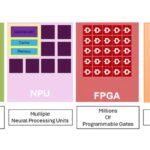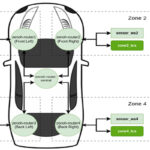When building edge AI systems, engineers often assume compute is the primary bottleneck. But in most cases, it’s the inefficiencies of data movement between sensors, memory, and processors that dominate power and latency. This article explains why and how in-memory-compute architectures can help.
Why your Edge AI chip falls short
Most engineers deploying AI at the edge hit the same paradox: the math works, yet the system burns too much power and struggles with real-time response. Your model is quantized, your accelerator is lean, and your inference window is tiny, yet your battery life suffers and real-time response falters.
It’s natural to look at the processor first. Maybe the neural engine isn’t optimized. Perhaps the instruction set lacks parallelism. But that’s rarely the root cause.
In reality, the major power draw in edge AI systems often isn’t the compute itself, it’s the movement of data.
Hidden costs of data movement
Consider a typical signal-processing pipeline: an analog sensor collects data, the signal is digitized by an ADC, written to memory, fetched by a processor, analyzed, and then pushed back out to another subsystem or memory buffer.
Each one of those memory and bus operations consumes energy. Depending on your architecture, a single read from SRAM can cost 10-100x more energy than a low-precision MAC (multiply-accumulate) operation.
And in edge devices, those reads and writes are constant. Your sensor streams 24/7, and to remain always-on, your AI model needs frequent updates. Even with optimized compute blocks, you lose efficiency by constantly moving data between cores, memory hierarchies, and interfaces.
Real bottleneck: memory
Most traditional AL chips treat memory as a passive component. The architecture is designed to move data to the compute unit, perform operations, and send results back.
But this design breaks down in edge scenarios:
- Sensor data is noisy and
- Memory bandwidth is
- Latency budgets are
- And battery power is
As a result, edge deployments are frequently forced to compromise by running smaller models, adding external power, or introducing duty cycling that increases latency and reduces reliability.
In-memory compute advantage
In-memory-compute (IMC) shifts the paradigm. Instead of transferring data from memory to logic blocks, IMC integrates the compute functions directly into the memory architecture.
This means that signal transformations, neural computations, or filters can be applied where the data resides, reducing bus traffic and idle energy consumption.
In analog implementations of IMC, operations like convolution or thresholding can occur within memory cells using charge-based or resistive elements, often without complete digitization. This avoids both ADC overhead and internal buffering.
Toolchain for IMC success
Implementing IMC architectures requires rethinking the entire software stack. Compilers for such systems must account for:
- Operator placement based on data locality
- Sensor-driven activation instead of polling
- Analog-aware scheduling of operations
- Custom instruction mapping for programmable memory blocks
Without these optimizations, even the most efficient hardware will underperform.
This pushes developers to rethink their toolchains, moving away from generic ML compilers toward ones tailored for event-based, memory-local processing.
Rethinking Edge AI design
If you’re an engineer working on edge AI systems, whether for wearables, industrial sensors, or smart home devices, here are a few takeaways to consider:
- Measure data movement, not just compute throughput. Your bottlenecks are likely hiding in memory and interconnects.
- Think event-first, not loop-first. The most efficient edge systems are those that only compute when real-world data demands it.
- Look for platforms that minimize copy operations and enable sensor fusion at the
- Choose processors that let you stay always-on without always burning power. Not all “low power” chips are optimized for real-time, battery-constrained use.
Efficiency as new benchmark
Recent implementations like Ambient Scientific’s GPX10 processor demonstrate these principles in action. By employing analog in-memory-compute blocks within its architecture, GPX10 achieves efficient always-on inference suitable for battery-constrained edge applications without requiring extensive data movement or external memory fetches.





Leave a Reply